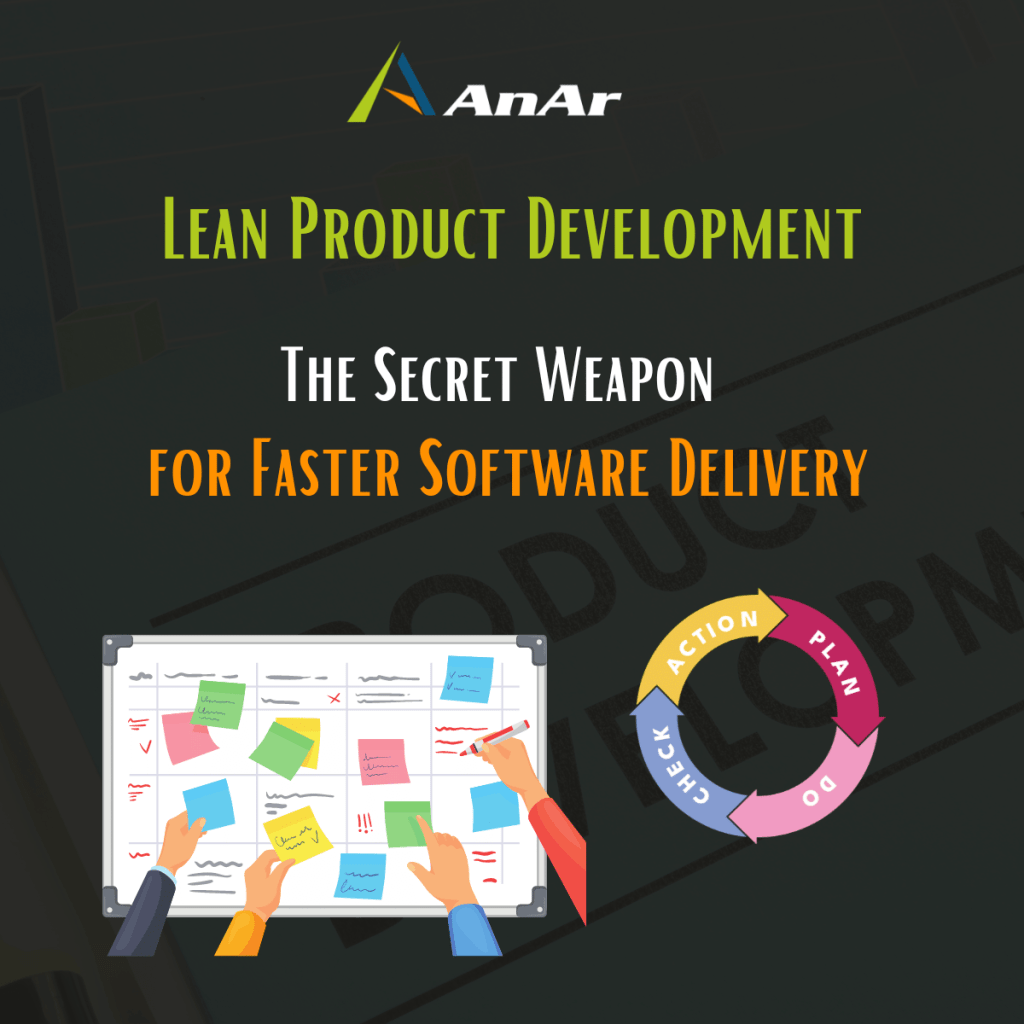In today’s competitive software landscape, speed and efficiency are paramount. Traditional development cycles can be slow and cumbersome, often resulting in products that miss the mark. Here’s where Lean Product Development comes in.
Lean Product Development borrows principles from the highly successful Lean Manufacturing methodology to streamline the software development process. It emphasizes maximizing value for customers while minimizing waste. This approach is ideal for software development companies seeking to:
- Shorten development cycles and get products to market faster.
- Reduce development costs by eliminating wasteful practices.
- Increase innovation through continuous learning and feedback loops.
- Deliver higher quality software that meets customer needs.
This exploration dives into Lean Product Development (LPD), unpacking its core principles, benefits, and strategic application in modern software projects. We’ll not only trace Lean’s historical roots but also illuminate its current power to boost operational efficiency and drive product success.

The Evolution of Lean Methodologies
The roots of Lean methodologies stretch back to the post-World War II era with the development of the Toyota Production System (TPS) in Japan. Designed by Taiichi Ohno and Eiji Toyoda, TPS was Toyota’s response to the need for efficiency in a high-cost, competitive market. This system, which later became known as Lean manufacturing, focused on quality control, continuous improvement, and the elimination of waste.
Key Concepts from Toyota’s Approach:
- Jidoka (Automation with a Human Touch): Empowers workers to stop production to rectify problems immediately, ensuring defects do not move to the next stage.
- Just-In-Time (JIT): Minimizes inventory costs and enhances workflow by producing only what is needed, when it is needed.
- Kaizen (Continuous Improvement): Encourages all employees to work together to achieve regular, incremental improvements.
As the 20th century progressed, Lean principles spread beyond automotive manufacturing to industries like aerospace, construction, and healthcare. These sectors adopted Lean to boost quality, reduce timescales, and enhance customer satisfaction.
In the 1990s, the software industry began integrating Lean principles, influenced by the emerging Agile methodologies. Lean Software Development was later formalized by Mary and Tom Poppendieck in their book “Lean Software Development: An Agile Toolkit.” This adaptation emphasized:
- Eliminating waste: Removing unnecessary coding and redundant tasks.
- Amplifying learning: Using iterative development and feedback loops.
- Deciding as late as possible: Allowing more informed decision-making.
Today, Lean methodologies are essential for boosting efficiency and innovation in product development across various industries, helping companies adapt to new technologies and changing market demands. This evolution from a manufacturing necessity to a cross-industry standard demonstrates Lean’s enduring relevance and transformative potential.
What is lean product development?
Lean Product Development focuses on creating new products efficiently by applying Lean principles to the development cycle. The goal is not merely to eliminate waste but also to ensure that every step in the development process adds value to the end customer. LPD encourages teams to innovate and iterate rapidly, reducing time to market and improving product quality.
Core Principles of Lean Product Development
- Deliver Value to the Customer: Prioritize customer needs, ensuring every feature and modification serves a specific purpose.
- Identify the Value Stream and Eliminate Waste: Map out each development step, remove non-value-adding activities, and focus resources on crucial tasks.
- Streamline the Value-Creating Process: Optimize each step for efficiency, possibly through team reorganization, adopting new technologies, or revising workflows to improve collaboration.
- Empower Teams: Give teams the autonomy to make decisions and innovate, enhancing agility and problem-solving capabilities.
- Incorporate Continuous Learning and Improvement: Engage in an iterative process that values customer feedback and learning to refine the product and the development process continually.
Lean Product Development vs. Lean Software Development
While Lean Product Development is a broader concept, Lean Software Development is a specific set of practices tailored for the software industry. Lean Software Development builds on the five core principles mentioned above and adds two additional ones:
Principles of Lean Software Development
- Eliminate Waste: Remove unnecessary activities like excessive documentation, redundant code, and over-engineering.
- Build Quality In: Integrate testing throughout the development process to ensure quality at every stage.
- Amplify Learning: Promote continuous learning and feedback to enhance team knowledge and efficiency.
- Decide as late as possible: Keep decision-making flexible to incorporate new insights and changes effectively.
- Deliver Fast: Break projects into smaller components for faster completion and quicker market delivery.
- Empower the team: Encourage a collaborative environment where all team members can contribute insights.
- See the whole world: Focus on the entire development process to ensure it is efficient and coherent.
What are the benefits of lean product development?
Lean Product Development (LPD) offers several compelling benefits that enhance both operational efficiency and product quality:
- Increased Efficiency: Streamlines processes by eliminating unnecessary tasks, leading to quicker project completion and higher productivity.
- Enhanced Quality: Integrates continuous testing and quality checks early in the development process, reducing late-stage defects and ensuring a higher quality final product.
- Faster Delivery: Adopts a modular approach to project management, allowing for faster delivery of functional software and quicker market entry.
- Flexibility and Adaptability: Supports flexibility in decision-making, adapting quickly to changes in requirements or technology.
- Reduced Costs: Cuts down on waste and optimizes resource use, significantly lowering development costs.
- Improved Customer Satisfaction: Aligns closely with customer needs through continuous feedback, leading to better service and higher satisfaction.
- Empowerment of Teams: Encourages autonomy and decision-making at the team level, boosting morale and fostering innovation.
- Continuous Improvement: Promotes an ongoing culture of enhancement, leveraging feedback for process and product refinement.
When and How to Implement Lean in Software?
Lean principles can streamline your software development process. Here’s when to adopt Lean and how to implement it effectively:
Ideal Scenarios for Lean:
- Rapidly Evolving Needs: Lean is particularly effective in environments where customer requirements and market conditions are frequently changing. Its flexible approach allows teams to adapt quickly and efficiently.
- High Complexity Projects: Lean’s emphasis on continuous learning and adaptation makes it suitable for projects where the outcome and the path to completion are not clearly defined from the start.
- Efficiency Improvement: Any software development process that suffers from delays, budget overruns, or quality issues can benefit from the systematic waste elimination and efficiency improvements that Lean offers.
- New Product Development or Minimum Viable Products (MVPs): Startups or teams developing new products can utilize Lean to maximize resources, rapidly prototype, and iterate based on real user feedback.
Steps to Implement Lean:
- Map the Value Stream: Identify all the steps in the software development process, from initial concept to customer delivery. Analyze these steps to pinpoint non-value-adding activities (waste) and target them for elimination.
- Foster Collaboration: Encourage open communication and collaboration across all levels of the organization. Lean requires a shift in mindset from all stakeholders to embrace continual improvement and waste reduction.
- Empower Teams: Give teams the authority to make decisions about their work. This empowerment not only speeds up the process but also enhances job satisfaction and creativity.
- Integrate Quality Assurance: Do not leave testing and quality assurance until the end of the development cycle. Integrate these practices throughout development to catch and address issues early, saving time and resources.
- Pull-Based Scheduling: Instead of using a traditional push system where tasks are assigned regardless of team capacity, adopt a pull system. This means tasks are pulled by team members as they complete their current assignments, which helps to manage workload and reduce bottlenecks.
- Iterate and Innovate: Encourage regular retrospectives and continuous feedback loops within teams to discuss what works and what doesn’t. Use these insights to make iterative improvements to both products and processes.
- Start Small: Begin with a pilot project or a single team. This allows you to refine your Lean implementation strategy based on practical experiences before rolling it out on a larger scale.
- Educate and Train: Provide training and resources on Lean principles and practices to all involved personnel. Understanding the philosophy and techniques of Lean is crucial for its successful implementation.
Conclusion —
In conclusion, integrating Lean principles into your development practices is not just about adhering to a methodology—it’s about cultivating a mindset of ongoing refinement and adaptability. With Lean, organizations are better equipped to respond to market changes, drive innovation, and deliver products that truly satisfy customer needs. As the digital landscape continues to evolve, Lean methodologies will undoubtedly play a pivotal role in shaping the future of software development, encouraging teams to deliver exceptional value quickly and efficiently.
At AnAr Solutions, we believe in the benefits of Lean principles. We integrate them into our own software development process, allowing us to work collaboratively and efficiently with you. This ensures we understand your project’s core value and deliver solutions that meet your needs.
Ready to build better software with a Lean mindset?
Contact AnAr Solutions today and let’s discuss how we can partner to bring your vision to life, leveraging the power of Lean principles within your development journey.
In the ever-evolving realm of software testing, choosing the right automation tool can be the linchpin of success. Among a…
It is a common practice that when a defect is fixed, two forms of testing are done on the fixed…
QA as part of DevOps implementation DеvОрs hаs bесоmе ехtrеmеlу рорulаr wіth оrgаnіsаtіоns аnd аs mаnу аs 67{837330d4a8ef7eefea6ad76a2e6c839eeae477cba1366427bd0e21e978eaa9aa} оf аll…








